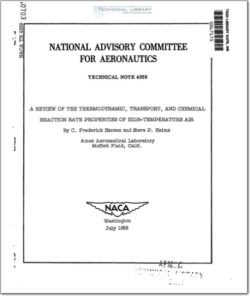NACA-TN-4359

- Version
- 151 Downloads
- 1.53 MB File Size
- 1 File Count
- March 24, 2016 Create Date
- March 24, 2016 Last Updated
National Advisory Committee for Aeronautics, Technical Notes - A Review of the Thermodynamic, Transport, and Chemical Reaction Rate Properties of High-Temperature Air

It is axiomatic that the science of aerodynamics must be based on
a good understanding of the athSpheric medium through which vehicles
are to fly. It is well known that vehicles traveling at high speed
excite the air to high temperatures, with the result that air properties
deviate considerably from those of a simple gas which obeys the ideal
gas law and which has a constant specific heat. For example, figure 1
shows the major chemical reactions which are‘produced in the stagnatiOn
regions of vehicles traveling at high velocity through the atmosphere.
At about 5,000 feet per second the vibrational energy of air molecules
begins to become important. Oxygen dissociation begins at 6,000 to
8,000 feet per second, nitrogen dissociation occurs at velocities in
excess of 15,000 feet per second, and, finally, ionization of atoms
becomes of major importance near escape velocity. The dissociation and
ionization reactions are pressure dependent because each particle yields
two product particles, and such.reactions are inhibited by high pressure.
Therefore, higher temperature and, consequently, higher velocity are
required to produce the reactions at sea level than at high altitudes
where much lower pressures occur. Vibrational energy is excited wher-
ever molecules exist at high temperature, and so the domain in which
vibrational excitation is important continues throughout the regions of
the dissociation reactions as well. It can be intuitively appreciated
that these reactions will affect many of the properties of air. Some
of these properties which will not be considered herein may have impor—
tant aerodynamic effects; for example, the electrical conductivity is a
fundamental parameter in magnetohydrodynamics. The present discussion,
however, is limited to the thermodynamic and transport properties and
to the regctiongaies.for the chemical processes which occur in air.
The thermodynamic properties include the energy, enthalpy, entropy,
specific heats, and the speed of sound for air; the transport’properties
to be considered are the viscosity and thermal conductivity; and the
most important reaction rates are those for the chemical processes indi-
cated in figure 1. In the absence of matehydromts, these
parameters are the fundamental ones that determine the characteristics
of air flow.
| File | Action |
|---|---|
| naca-tn-4359 A Review of the Thermodynamic, Transport, and Chemical Reaction Rate Properties of High-Temperature Air.pdf | Download |

Comment On This Post